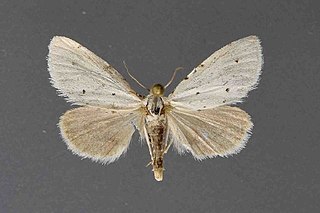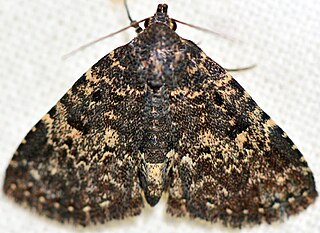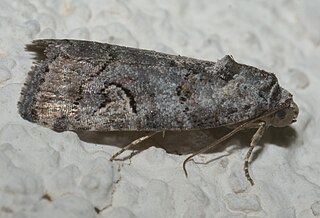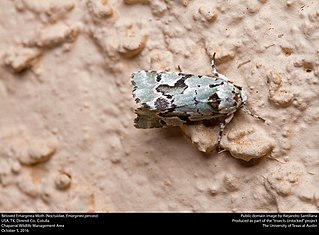
Acontiinae is a subfamily of bird dropping moths in the family Noctuidae. There are more than 50 genera and 430 described species in Acontiinae, found worldwide in temperate and tropical climates.
Apilocrocis is a genus of moths of the family Crambidae.
Afotella is a monotypic moth genus of the family Noctuidae erected by William Barnes and Foster Hendrickson Benjamin in 1926. Its only species, Afotella cylindrica, was first described by Augustus Radcliffe Grote in 1880. It is found in western North America from Saskatchewan and Alberta south to California.

Euxoa is a genus of moths of the family Noctuidae raised to Genus by the German entomologist, Jacob Hübner. The Genus is mostly confined to dry and semi dry areas in the Northern Hemisphere. There 130 species in Eurasia, a few in Africa, and 175 in North America. There are no species in the Genus in South-East Asia or in Australia. In North America, most species are found in Western regions. Of the North American species, 4 are endemic to Mexico. There is one species recorded from Chile, but this may be a mislabeled specimen. In real terms, species numbers do not equal species abundance. Some areas with few species have large numbers of the ones that do live there.

Grotellaforma is a monotypic moth genus of the family Noctuidae erected by William Barnes and Foster Hendrickson Benjamin in 1922. Its only species, Grotellaforma lactea, was first described by Stretch in 1885. It is found in North America, including California and Arizona, its type locations.
Hemioslaria is a monotypic moth genus of the family Noctuidae. Its only species, Hemioslaria pima, is known from the US state of Arizona. Both the genus and species were first described by William Barnes and Foster Hendrickson Benjamin in 1924.
Properigea is a genus of moths of the family Noctuidae. The genus was erected by William Barnes and Foster Hendrickson Benjamin in 1926.

Hypoprepia miniata, the scarlet-winged lichen moth or scarlet lichen moth, is a moth of the family Erebidae. The species was first described by William Kirby in 1837. It is found from British Columbia south through the western side of the Rocky Mountains to Arizona and Texas. It is also found throughout eastern North America.
Cacotherapia lecerfialis is a species of snout moth in the genus Cacotherapia. It was described by William Barnes and Foster Hendrickson Benjamin in 1925 and is known from the US state of California.
Gazoryctra novigannus is a moth of the family Hepialidae first described by William Barnes and Foster Hendrickson Benjamin in 1926. It is known in North America, from Quebec, west to the Rocky Mountains and south to Arizona.
Satyrium polingi, or Poling's hairstreak, is a butterfly of the family Lycaenidae. It was described by William Barnes and Foster Hendrickson Benjamin in 1926. It is found in North America from southern New Mexico and western Texas south to north-eastern Mexico. The habitat consists of oak woodlands.

Cisthene juanita is a moth of the family Erebidae. It was described by William Barnes and Foster Hendrickson Benjamin in 1925 and is found in the United States in southern Arizona.
Comadia intrusa is a moth in the family Cossidae first described by William Barnes and Foster Hendrickson Benjamin in 1923. It is found in North America, where it has been recorded from New Mexico, Arizona and California.
Eudonia bronzalis is a moth in the family Crambidae. It was described by William Barnes and Foster Hendrickson Benjamin in 1922. It is found in North America, where it has been recorded from California.

Noctueliopsis aridalis is a moth in the family Crambidae. It was described by William Barnes and Foster Hendrickson Benjamin in 1922. It is found in North America, where it has been recorded from Arizona, California and Nevada. The habitat consists of deserts.
Apilocrocis brumalis is a moth in the family Crambidae. It was described by William Barnes and James Halliday McDunnough in 1914. It is found in Mexico and the southern United States, where it has been recorded from southern Texas.

Metalectra diabolica, the diabolical fungus moth, is a moth of the family Erebidae. The species was first described by William Barnes and Foster Hendrickson Benjamin in 1924. It is found in North America, where it has been recorded from North Carolina to Florida and Arkansas to Texas.

Triocnemidina is a subtribe of owlet moths in the family Noctuidae. There are about 16 genera and at least 30 described species in Triocnemidina.

Psaphidini is a tribe of owlet moths in the family Noctuidae. There are at least 40 genera and at least 90 described species in Psaphidini.
Caradrina camina is a species of cutworm or dart moth in the family Noctuidae. It is found in North America.








